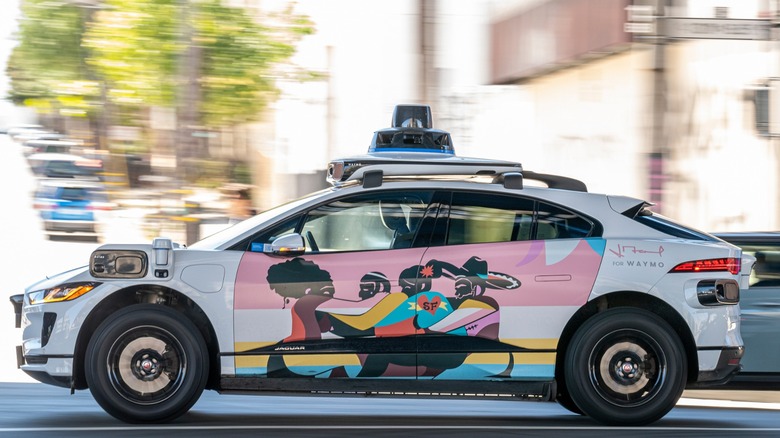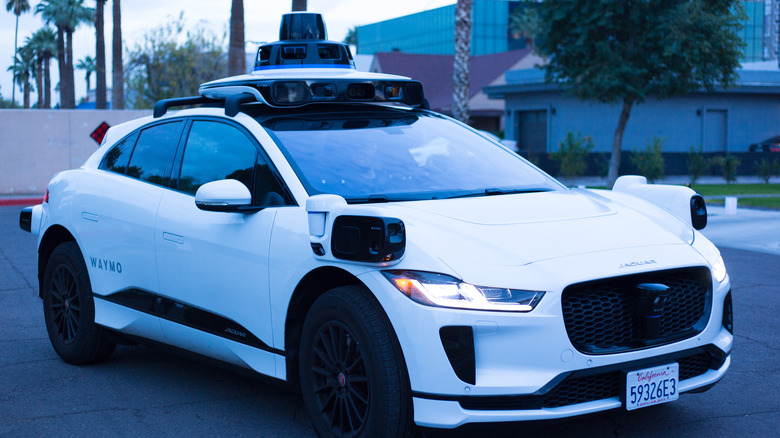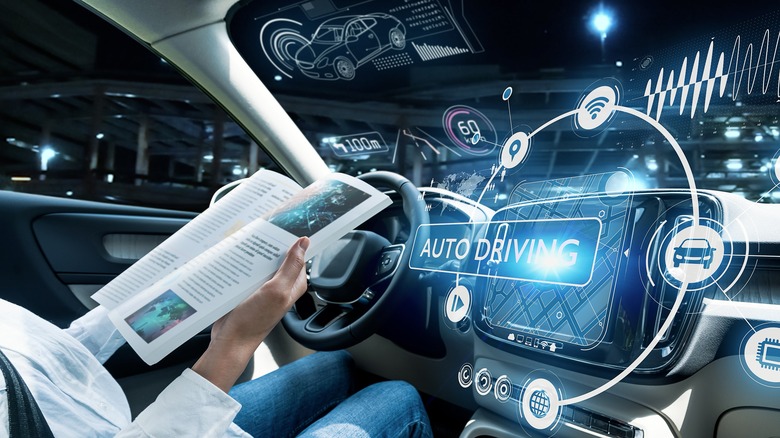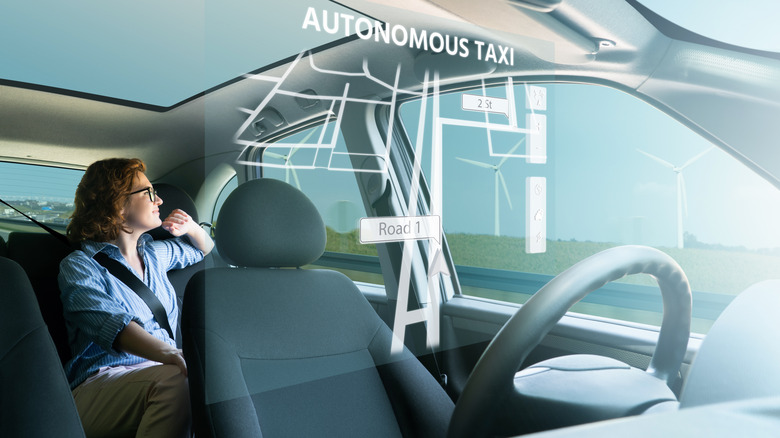Can You Still Get A DUI Or DWI In A Self-Driving Car?
Asking that question with a straight face means we're finally living in a world where this is really happening. It's no longer the pie-in-the-sky platitudes of some 1960s futurist or a cartoon from the zany minds of Hanna-Barbera.
There are, of course, more than a few things we must clarify first. At the moment, you can't simply walk into an automobile dealer and purchase a true self-driving car. While today's modern modes of transport have features like Tesla's Autopilot, Ford's BlueCruise, and General Motors' hands-free Super Cruise that may all seem autonomous, they're really just driver assistance systems meant to help reduce stress and overall workload. All of them still require one key component — someone must be sitting in the driver's seat behind the wheel.
Even Tesla, with its "Full Self-Driving Capability," includes disclaimers that clearly state it — along with Autopilot and Enhanced Autopilot modes — requires a driver's direct supervision, thus precluding it from being truly autonomous. However, in a few select U.S. cities, genuinely autonomous vehicles that are utterly devoid of a driver are, in fact, navigating streets. These vehicles aren't for sale to the general public, but safety testing with them has been conducted.
Waymo (owned by Alphabet Inc., which also owns Google) operates in parts of Phoenix and San Francisco and is gearing up to provide service to Los Angeles. Cruise (a subsidiary of General Motors) was operating in Phoenix, Arizona, and the Texas cities of Austin and Houston.
Automated vehicles have had their issues
We say Cruise "was" operating because its robotaxis started running into problems — and quite literally, people. In October 2023, California's Department of Motor Vehicles suspended its permit after car accidents and found the company had "misrepresented" the vehicle's overall safety. Cruise subsequently shuttered operations nationwide.
Waymo, on the other hand, made news in February 2024 when one of its cars bumped into a bicyclist. The point is that despite two tech giants testing real-world autonomous vehicles on the road (Waymo having exceeded 1 million miles of testing), both are having difficulty fashioning a future without drivers.
With several other behemoth companies — from Amazon to Apple, not to mention other automakers, working towards the same goal, vehicles without anyone behind the wheel could be the future. Having observed several of these driving through the streets of San Francisco, we can tell you it's a very odd sight to behold.
All of which begs the question, if you're not in the driver's seat, are you technically "operating the vehicle?" It's one critical facet of a DUI charge, which includes other factors like whether the engine is operating, the keys are in the ignition, the tires are warm, and if the vehicle is on the side of the road. Those are just the "basics" because these new-fangled technologies have muddied the waters. In fact, there are now six legal levels of autonomy to consider as defined by the National Highway Traffic Safety Administration (NHTSA).
The NHTSA levels of autonomy
Modern Level 0 (Momentary Driving Assistance) cars have standard features, such as cruise control, automatic emergency braking, forward collision warning, or lane departure warning. These merely assist but don't control the vehicle in any way. Moving up to Level 1 (Driver Assistance), you'll find vehicles with driver support features like adaptive cruise control or lane-keeping assistance. It helps with steering or acceleration and braking, but not both. Again, the driver must be at the helm, vigilant, and ready to take control immediately.
Level 2 (Additional Assistance) includes autos with integrated active driving assistance, meaning they can steer, accelerate, and brake. A highway pilot feature on the open road is one such example. Still, a driver must be behind the wheel monitoring vehicle operations.
The technology found in Level 3 (Conditional Automation) cars isn't available in the United States yet. In effect, these use artificial intelligence to perform what the NHTSA calls conditional driving. It can adapt automatically to the conditions and scenarios while the driver ignores its operation. Still, they must be able to take over if the system fails or is prompted to take control.
Level 4 (High Automation) vehicles are also unavailable, but Waymo and Cruise robotaxis slide into this category. The systems are so advanced that a driver isn't needed; in some cases, the car might not even have driving controls. It can only operate in limited areas, whereas a Level 5 car can operate anywhere under any condition without human control.
DUI laws and robotaxis
The level of autonomy matters when it comes to a DUI charge. However, it boils down to some basic tenets, such as drunk driving impacts human motor skills and behavior, not machine function. So, a person riding inebriated inside a wholly autonomous vehicle wouldn't impact how that vehicle operates because they have no control over it, right?
Such a scenario would only apply to a car with an NHTSA level of four or greater, which doesn't exist outside of Waymo and Cruise robotaxis in the United States. Legislation on a state level is still forming, so restrictions depending on state and locality matter a lot in this case. In contrast, semi-autonomous vehicles with "driver assist" features are prevalent, so a drunk driver would be considered maintaining some degree of control and thus would likely be charged.
Can you get a DUI if you're in one of these robotaxis? Well, maybe. You're not allowed to use alcohol or drugs while inside one, but there's no way to stop an already inebriated passenger from entering one. According to Nolo, a network that helps solo practitioners and smaller law firms, if you find an employee of the taxi company behind the wheel, "you should be fine." If the driver seat is empty, though, you're taking your chances because you are, at least in some small degree, "operating" the vehicle.
Real world application of the law is limited
Texas Transportation Code §545.453 makes the owner of an autonomous vehicle solely accountable for observing all motor vehicle laws. In North Carolina, the statute for impaired driving (§ 20-138.1) says anyone who "drives any vehicle upon any highway, any street, or any public vehicular area within this State."
According to Raleigh-based law firm Sandman, Finn & Fitzhugh, this has been interpreted by the courts to include someone who wasn't actually driving but was still considered physically in control of the vehicle. This is echoed in Tampa Bay, Florida, where a person can still be charged as long as they can use any of the car's features. Meanwhile, in Arizona, DUI law states that Actual Physical Control (APC) doesn't require the vehicle to be in motion for someone to be considered "in physical control."
Ultimately, it's always best to check your local laws. Still, it appears that even if you're not physically driving, the simple act of operating or being in control of any part of the vehicle is enough to get a DUI charge in many places. So, at least for now, it's probably best to stick with Uber and Lyft because the odds of getting into trouble in a self-driving car while intoxicated are high with the technology that exists, and the thrill simply isn't worth the gamble.




